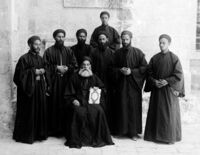History of Djedet
Prehistory
Faras Civilization
Atouan Culture
Ancient Djedet
Old Kingdom
Atouan Kingdom
First Intermediate Period
Middle Kingdom
Second Intermediate Period
New Kingdom
Kingdom of Medewi
Bedouin rule
Banu Hashid
Second Kingdom of Medewi
Banu Azd
Sotirian rule
Spread of Sotirianity
Empire of Mina
Kingdom of Bashans and Souan
Irfani rule
First Ghazi Dynasty
Second Ghazi Dynasty
Empire of Beheira
Kingdom of Souan
Conquest of the Faras
Lourale ka Maoube
Djaladjie
Modernization
During the second half of the nineteenth century, the colonisation of Bahia brought Beheira into closer contact with Euclea, forcing the people of the Faras to recognise that they had been surpassed in military and economic might. Though the Beheiran elite remained convinced of their cultural and religious superiority, reformers argued that Beheira needed to adapt to the ideas and technologies of Euclea if they wanted to maintain their independence. Surrounded by Gaullican colonies, Beheira was entering a new era in its relations with the north.
In 1840, Emperor Ashraf II sent a delegation of 40 clerics, scholars, and diplomats to study Euclean science and forms of government in Gaullica. Among the delegation was Tawadros Ramtanthanos, a cleric at the University of St. Maryma who had travelled throughout colonial Bahia and Tsabara. In Overview of Verlois, he describes his travels through Gaullica. Having studied developments in liberal thought and the revolutions of the 19th century, Remtanthanos was impressed by the Gaullican constitution, particularly its guarantees of equal rights and constraints on the authority of the king. Noting that Bahia had fallen behind the north, he argued that Gaullica owed its superiority to its liberal institutions. Remtanthanos was an active constitutionalist by the time he returned in 1852. In Foundations of the State, he asserted that Beheira needed a constitution that limited the authority of the emperor and replaced Hourege with a meritocratic civil service. Though Remtanthanos' message resonated with Remtanthanos' contemporaries, Beheira was an autocratic state and his praise for representative government were seen as foreign and subversive by Beheiran elites.

In 1852, the Nizam al-Jadid, an army of recruits drawn from rural communities was created. Ashraf II hired retired Gaullican officers to train the soldiers to fight with modern weapons and methods of warfare. This was the first standing army in Beheiran history. Traditionally, the Beheiran state relied on the badawi to supply the emperor with Makanian slave-soldiers in times of war. As Southern Makania fell under the control of Gaullica, the supply of slaves dried up and the badawi became obsolete. The idea of a standing army of citizen conscripts was still new in the Orthodox world and was met with resistance. Peasants fearing for their farms and the welfare of their families avoided conscription by fleeing their communities when military recruitment teams approached. The regions of Bashans and Souan rebelled against the draft. Despite the initial difficulties, the situation stabilized. In 1854, the army numbered 20,000 men. In 1864, it numbered 100,000 men.
However, maintaining the Nizam Al-Jadid required revenues that the Beheiran state did not have. Agriculture accounted for over 80% of Beheira's revenues. However, 30% of arable land was owned by the Orthodox Church and its monasteries. The other 70% was owned by large landholders who paid little to the treasury in Mina. If Ashraf II wanted to control Beheira's revenues, he had to control its land. From 1853 to 1859, he confiscated millions of feddan from the landed elite.
On 8 November 1857, Emperor Tawadros IV read a reform decree drafted by Prime Minister Abdelmesseh al-Dishairi to the Consultative Council. The decree called on the government to reform the tax system, modernise the financial system, and reform the terms of military service. The decree also called for the foundation of a national bank to create funds for public works such as roads, railways, and canals. To reform the tax system, the government began to conduct a regular census using a system of land records that replaced traditional tax farms and communal holdings with individual titles, introducing northern notions of property for the first time. These reforms required thousands of bureaucrats with technical training to carry them out. During the 1850s and 60s, the government opened a network of schools and colleges that taught Euclean curricula to train civil servants. In 1860, all Beheiran laws were codified.
Gaullican Protectorate
Gaullican Invasion
Beheiran nationalism

Coming to terms with Catholic rule, Orthodox reformers and secular nationalists drafted their own responses to Gaullican imperialism. Led by Bishop Sarjoun of Dotawo and Mikhail Bestawros, the reformists laid the foundation for the anastasis, a movement that aimed to adapt Southern Orthodoxy to the modern world, calling for a new interpretation of the Bible capable of addressing the challenges of the 19th century. In 1886, Bestawros founded the Orthodox League, a political party that hoped to constrain the power of the emperor through a constitution based on Sotirian principles and present a united front of Bahian Sotirians led by Beheira against Gaullican imperialism.
Despite the Gaullican occupation, the spread of the printing press and the telegraph led to a literary revival known as the nahda. Intellectuals from Mina to Souan were actively writing books on Beheiran history and culture and commentaries on classical works of Beheiran literature. The nahda was a moment of cultural definition and rediscovery and laid the foundation for Beheiran nationalism. In 1892, Abassad Beshada and Harun Remtanthanos founded the Nahda Party. Beshada and Remtanthanos agreed with the constitutionalism of the Orthodox League but rejected its pan-Sotirian ambitions. In al-Sawt, the party newspaper, Beshada argued that Beheira was a direct descendant of Ancient Djedet and that the Beheirans and Makai were a nation united by a common history, culture, and religion. al-Sawt and other newspapers provided the nascent nationalist movement with broad support among students and intellectuals. By the beginning of the 20th century, Nahda, followed by the Orthodox League, was the largest political party in the country.
